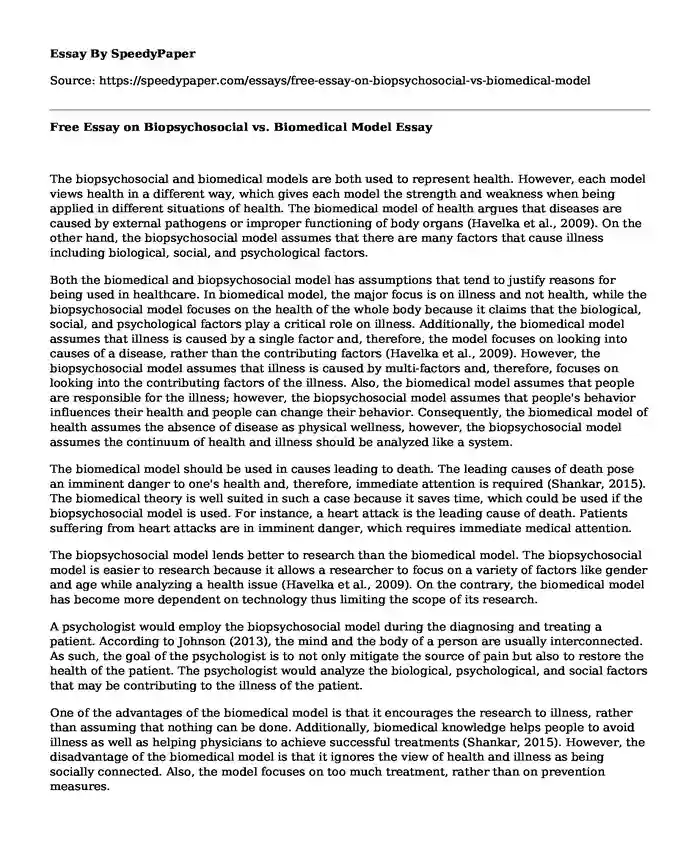The biopsychosocial and biomedical models are both used to represent health. However, each model views health in a different way, which gives each model the strength and weakness when being applied in different situations of health. The biomedical model of health argues that diseases are caused by external pathogens or improper functioning of body organs (Havelka et al., 2009). On the other hand, the biopsychosocial model assumes that there are many factors that cause illness including biological, social, and psychological factors.
Both the biomedical and biopsychosocial model has assumptions that tend to justify reasons for being used in healthcare. In biomedical model, the major focus is on illness and not health, while the biopsychosocial model focuses on the health of the whole body because it claims that the biological, social, and psychological factors play a critical role on illness. Additionally, the biomedical model assumes that illness is caused by a single factor and, therefore, the model focuses on looking into causes of a disease, rather than the contributing factors (Havelka et al., 2009). However, the biopsychosocial model assumes that illness is caused by multi-factors and, therefore, focuses on looking into the contributing factors of the illness. Also, the biomedical model assumes that people are responsible for the illness; however, the biopsychosocial model assumes that people's behavior influences their health and people can change their behavior. Consequently, the biomedical model of health assumes the absence of disease as physical wellness, however, the biopsychosocial model assumes the continuum of health and illness should be analyzed like a system.
The biomedical model should be used in causes leading to death. The leading causes of death pose an imminent danger to one's health and, therefore, immediate attention is required (Shankar, 2015). The biomedical theory is well suited in such a case because it saves time, which could be used if the biopsychosocial model is used. For instance, a heart attack is the leading cause of death. Patients suffering from heart attacks are in imminent danger, which requires immediate medical attention.
The biopsychosocial model lends better to research than the biomedical model. The biopsychosocial model is easier to research because it allows a researcher to focus on a variety of factors like gender and age while analyzing a health issue (Havelka et al., 2009). On the contrary, the biomedical model has become more dependent on technology thus limiting the scope of its research.
A psychologist would employ the biopsychosocial model during the diagnosing and treating a patient. According to Johnson (2013), the mind and the body of a person are usually interconnected. As such, the goal of the psychologist is to not only mitigate the source of pain but also to restore the health of the patient. The psychologist would analyze the biological, psychological, and social factors that may be contributing to the illness of the patient.
One of the advantages of the biomedical model is that it encourages the research to illness, rather than assuming that nothing can be done. Additionally, biomedical knowledge helps people to avoid illness as well as helping physicians to achieve successful treatments (Shankar, 2015). However, the disadvantage of the biomedical model is that it ignores the view of health and illness as being socially connected. Also, the model focuses on too much treatment, rather than on prevention measures.
The advantage of using a biopsychosocial model is that it advocates for better treatment because it focuses on both micro and macros causes of illness (Pilgrim, 2015). Another advantage is that the model advocates for good mental and emotional health thus promoting a healthy lifestyle. However, using a biopsychosocial model is a disadvantage because it assumes that all mental illnesses are biopsychosocial, which may lead to a confusing treatment with severe consequences to the patient. Also, the model can be confusing and difficult to employ for new users. The complexity of the model may lead to a misunderstanding of proper diagnosis and treatment of patients.
References
Havelka, M., Despot Lucanin, J., & Lucanin, D. (2009). Biopsychosocial model-the integrated approach to health and disease. Collegium antropologicum, 33(1), 303-310.
Johnson, S. B. (2013). Increasing psychology's role in health research and health care. American Psychologist, 68(5), 311.
Pilgrim, D. (2015). The biopsychosocial model in health research: its strengths and limitations for critical realists. Journal of Critical Realism, 14(2), 164-180.
Shankar, D. (2015). Health sector reforms for 21st-century healthcare. Journal of Ayurveda and integrative medicine, 6(1), 4.
Cite this page
Free Essay on Biopsychosocial vs. Biomedical Model. (2023, Jan 18). Retrieved from https://speedypaper.net/essays/free-essay-on-biopsychosocial-vs-biomedical-model
Request Removal
If you are the original author of this essay and no longer wish to have it published on the SpeedyPaper website, please click below to request its removal:
- Free Essay on Modern Technology Used in Agriculture
- Finance Essay Example: Assessment of Financial Statements
- Chemotherapy Essay Example
- Essay Sample Describing the Experience of Team's Leadership
- Essay Sample on Corporate Culture at Enron
- Community Health Needs Assessment - Free Essay Sample
- Enhancing Health Information Management and Exchange for Children with Tracheotomy - Essay Sample
Popular categories





